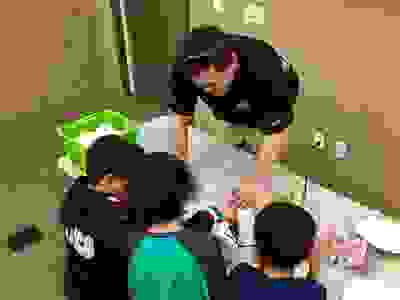Youth Development
Kids & Cops
Healthy & Happy
Sports & Games
Police officers & youth interact in fun activities & build positive relations.
Sports & Games
Healthy & Happy
Sports & Games
Police officers engage students during physical education classes, recess, & after school programs.
Healthy & Happy
Healthy & Happy
Healthy & Happy
Police officers & social workers teach skills that improve student's physical & social-emotional health.
Youth Development Program
Teams made up of one police officer and one social service professional are trained in social emotional learning (SEL) techniques. Police officers & prevention specialists use SEL to build positive relations & teach youth emotional self-regulation, interpersonal skills & problem-solving through play, athletics & performing arts.
Takes place within elementary school recess time, middle school physical education classes, out-of-school time programs, libraries, & recreation centers.

Protective and Risk Factors
What are Risk and Protective Factors?
Protective factors exert a positive influence and buffer
against the negative influence of risk, thus reducing the
likelihood that adolescents will engage in problem be-
haviors.
Risk factors are characteristics of school, community
and family environments, and of students and their
peer groups known to predict increased likelihood of
drug use, delinquency, school dropout, and violent be-
haviors among youth.
Research on risk and protective factors has important
implications for children’s academic success, positive
youth development, and prevention of health and be-
havior problems.

Protective Factor Examples

Community Rewards
Rewards for positive participation in activities helps youth bond to the community, thus lowering their risk for substance use.
Family Rewards
When parents, siblings, and other family members praise, encourage, and attend to things done well by their child, children are less likely to engage in substance use and problem behaviors.
School Rewards
When young people are recognized and rewarded for their contributions at school, they are less likely to be involved in substance use and other problem behaviors.
Family Attachment
Young people who feel that they are a valued part of their family are less likely to engage in substance use and other problem behaviors.
Family Opportunities
Young people who are exposed to more opportunities to participate meaningfully in the responsibilities and activities of the family are less likely to engage in drug use and other problem behaviors.
Prosocial Peers
Participation in positive school and community activities helps provide protection for youth.
Risk Factor Examples

Low Neighborhood Attachment
Low neighborhood bonding is related to higher levels of juvenile crime and drug selling.
Low School Commitment
Surveys of high school seniors have shown that the use of drugs is significantly lower among students who expect to attend college than among those who do not. Factors such as liking school, spending time on homework, and perceiving the coursework as relevant are also negatively related to drug use.
High Family Conflict
Children raised in families high in conflict, whether or not the child is directly involved
in the conflict, appear at risk for both delinquency and drug use.
Rewards for Antisocial Behavior
Young people who receive rewards for their antisocial behavior are at higher risk for engaging further in antisocial behavior and substance use.
Attitudes Favoring Antisocial Behavior
During the elementary school years, most children express anti-crime and pro-social
attitudes and have difficulty imagining why people engage in antisocial behaviors. However, in middle school, as more youth are exposed to others who engage in antisocial behavior, their attitudes often shift toward greater acceptance of these behaviors. Youth who express positive attitudes toward antisocial behavior are more likely to engage in a variety of problem behaviors.
Antisocial Peers
Young people who associate with peers who engage in problem behaviors are at higher risk for engaging in antisocial behavior themselves.
Locations

Salt Lake City School District
- Glendale Middle School
- Northwest Middle School
- Bryant Middle School
- Jackson Elementary School
- Meadowlark Elementary School
- Riley Elementary School
- Rose ParkElementary School
- Backman Elementary School
- Mountain View Elementary School
- WashingtonElementary School
- Edison Elementary School
- Franklin Elementary School
- Newman Elementary School
Salt Lake County
- Magna Library
- Kearns Library
- Youth Services School Based Programs
Law Enforcement Agencies
- Salt Lake City Police Department
- Unified Police Department
- West Valley Police Department
Program Specifics
Youth Development Services
Youth Development Services
Youth Development Services
- iCHAMPS teams of police officers & youth workers teach elementary & middle school students social emotional learning skills such as:
- Emotional self-regulation
- Interpersonal relations
- Problem-solving
- Healthy alternatives to drug use
- Resistance techniques to antisocial behavior
- Outcomes:
- Increase social-emotional skills & prosocial behaviors
- Prevent drug use & violent behaviors
- Increase sense of belonging
- Increase positive community-police relations & legitimacy of police
Evidence-Based Programs
Youth Development Services
Youth Development Services
- Life Skills Training (LST) has been found to prevent or reduce:
- Violent behaviors
- Tobacco, alcohol, marijuana & illegal drug use
- Delinquent behaviors
- HIV risky behaviors
- Risky driving
- Promoting Alternative Thinking Strategies (PATHS) has been found to:
- Increase social-emotional learning skills (emotional self-regulation, interpersonal skills, & problem-solving)
- Improve academic achievement (reading, writing & math)
- Reduce conduct problems & ADHD/depressive symptoms
Copyright © 2021 iCHAMPS - All Rights Reserved.